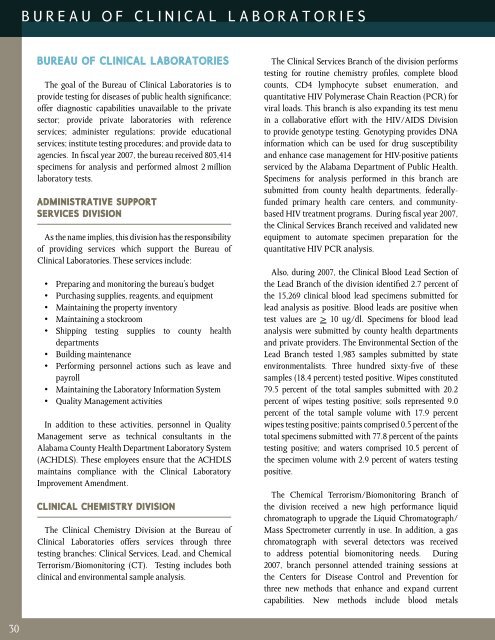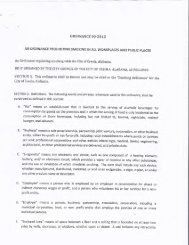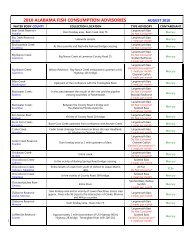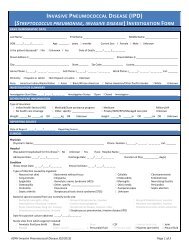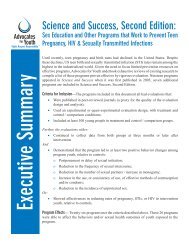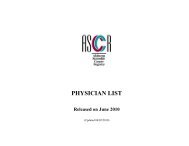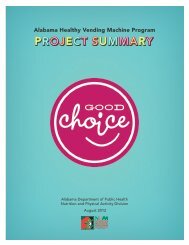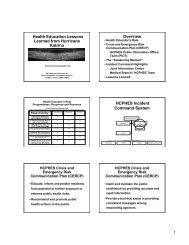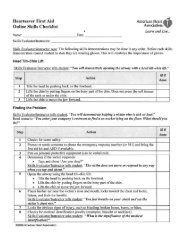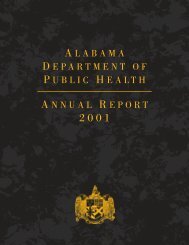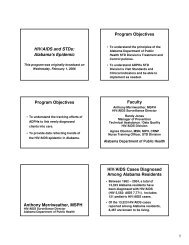2007 - Alabama Department of Public Health
2007 - Alabama Department of Public Health
2007 - Alabama Department of Public Health
Create successful ePaper yourself
Turn your PDF publications into a flip-book with our unique Google optimized e-Paper software.
ureau <strong>of</strong> clinical laboratories<br />
Bureau <strong>of</strong> Clinical Laboratories<br />
The goal <strong>of</strong> the Bureau <strong>of</strong> Clinical Laboratories is to<br />
provide testing for diseases <strong>of</strong> public health significance;<br />
<strong>of</strong>fer diagnostic capabilities unavailable to the private<br />
sector; provide private laboratories with reference<br />
services; administer regulations; provide educational<br />
services; institute testing procedures; and provide data to<br />
agencies. In fiscal year <strong>2007</strong>, the bureau received 803,414<br />
specimens for analysis and performed almost 2 million<br />
laboratory tests.<br />
Administrative Support<br />
Services Division<br />
As the name implies, this division has the responsibility<br />
<strong>of</strong> providing services which support the Bureau <strong>of</strong><br />
Clinical Laboratories. These services include:<br />
• Preparing and monitoring the bureau’s budget<br />
• Purchasing supplies, reagents, and equipment<br />
• Maintaining the property inventory<br />
• Maintaining a stockroom<br />
• Shipping testing supplies to county health<br />
departments<br />
• Building maintenance<br />
• Performing personnel actions such as leave and<br />
payroll<br />
• Maintaining the Laboratory Information System<br />
• Quality Management activities<br />
In addition to these activities, personnel in Quality<br />
Management serve as technical consultants in the<br />
<strong>Alabama</strong> County <strong>Health</strong> <strong>Department</strong> Laboratory System<br />
(ACHDLS). These employees ensure that the ACHDLS<br />
maintains compliance with the Clinical Laboratory<br />
Improvement Amendment.<br />
clinical Chemistry Division<br />
The Clinical Chemistry Division at the Bureau <strong>of</strong><br />
Clinical Laboratories <strong>of</strong>fers services through three<br />
testing branches: Clinical Services, Lead, and Chemical<br />
Terrorism/Biomonitoring (CT). Testing includes both<br />
clinical and environmental sample analysis.<br />
The Clinical Services Branch <strong>of</strong> the division performs<br />
testing for routine chemistry pr<strong>of</strong>iles, complete blood<br />
counts, CD4 lymphocyte subset enumeration, and<br />
quantitative HIV Polymerase Chain Reaction (PCR) for<br />
viral loads. This branch is also expanding its test menu<br />
in a collaborative effort with the HIV/AIDS Division<br />
to provide genotype testing. Genotyping provides DNA<br />
information which can be used for drug susceptibility<br />
and enhance case management for HIV-positive patients<br />
serviced by the <strong>Alabama</strong> <strong>Department</strong> <strong>of</strong> <strong>Public</strong> <strong>Health</strong>.<br />
Specimens for analysis performed in this branch are<br />
submitted from county health departments, federallyfunded<br />
primary health care centers, and communitybased<br />
HIV treatment programs. During fiscal year <strong>2007</strong>,<br />
the Clinical Services Branch received and validated new<br />
equipment to automate specimen preparation for the<br />
quantitative HIV PCR analysis.<br />
Also, during <strong>2007</strong>, the Clinical Blood Lead Section <strong>of</strong><br />
the Lead Branch <strong>of</strong> the division identified 2.7 percent <strong>of</strong><br />
the 15,269 clinical blood lead specimens submitted for<br />
lead analysis as positive. Blood leads are positive when<br />
test values are > 10 ug/dl. Specimens for blood lead<br />
analysis were submitted by county health departments<br />
and private providers. The Environmental Section <strong>of</strong> the<br />
Lead Branch tested 1,983 samples submitted by state<br />
environmentalists. Three hundred sixty-five <strong>of</strong> these<br />
samples (18.4 percent) tested positive. Wipes constituted<br />
79.5 percent <strong>of</strong> the total samples submitted with 20.2<br />
percent <strong>of</strong> wipes testing positive; soils represented 9.0<br />
percent <strong>of</strong> the total sample volume with 17.9 percent<br />
wipes testing positive; paints comprised 0.5 percent <strong>of</strong> the<br />
total specimens submitted with 77.8 percent <strong>of</strong> the paints<br />
testing positive; and waters comprised 10.5 percent <strong>of</strong><br />
the specimen volume with 2.9 percent <strong>of</strong> waters testing<br />
positive.<br />
The Chemical Terrorism/Biomonitoring Branch <strong>of</strong><br />
the division received a new high performance liquid<br />
chromatograph to upgrade the Liquid Chromatograph/<br />
Mass Spectrometer currently in use. In addition, a gas<br />
chromatograph with several detectors was received<br />
to address potential biomonitoring needs. During<br />
<strong>2007</strong>, branch personnel attended training sessions at<br />
the Centers for Disease Control and Prevention for<br />
three new methods that enhance and expand current<br />
capabilities. New methods include blood metals<br />
30


